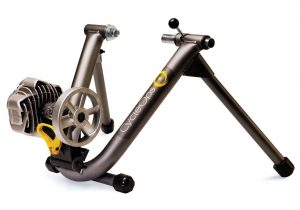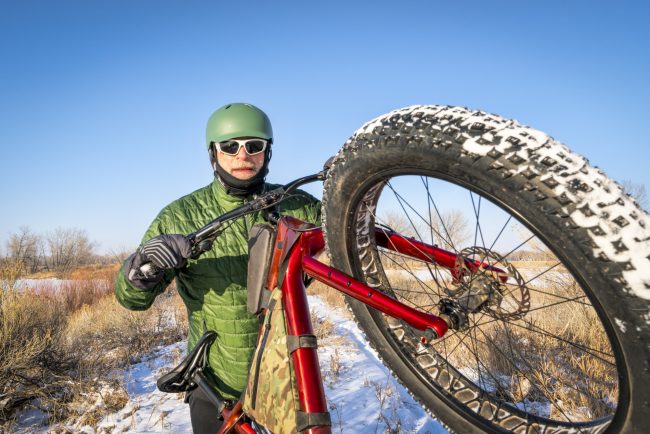Hannah Diaz is a professional soccer player, currently with the Houston Dash. Hannah’s expertise expands to sports nutrition, general fitness, and running. She has coached soccer and conditioning sessions for athletes at many levels. She is a regular contributing writer for Complete Tri.
In the depths of winter, triathletes and cyclists in Northern climates have to adjust their training to the weather. Some stay outdoors (minus the swim) as much as humanly possible for their training, while others tend to take it inside at a health club or gym for several months. While we are fans of being outdoors as much as possible, and think that there are many reasons to keep training outside even in cold weather, occasionally there is a day that is too nasty or workout that you just can’t do outside in the cold.

Location is everything as well. If you have access to good trails, you have a different situation available to you than if you can only ride on roads. First and foremost, we want you to be safe, so make sure you are only riding in areas where you are not increasing your odds of an accident. Safety first.
While Running in winter is pretty straightforward – you just layer up and pick your path carefully, and you can usually stay outdoors for most if not all of the winter, cycling training is a little more complex in cold weather. When it comes to cycling in winter, we have experimented with a little of everything, and see pros and cons in several approaches. We have ridden our road bike on hard pack trails. We have transitioned to fat bikes. We’ve gone inside.
As with all things training-related, the right answer you is probably a thoughtful blend of a few different approached to keep yourself in great bike shape until Spring. Here are three winter cycling training approaches, along with our thoughts on each.
Winter Cycling Options
Option 1: Stay Outside Year-Round. If you live in Southern California or Florida, this one is probably pretty easy. You just do in January what you were doing in June. For those of us in the Mountains, Midwest, North, or Northeast, however, it isn’t so simple. Being outside on your bike at a minimum requires changing your setup and adapting some of our routes. Many cyclists move to fatter bike tires in the winter or change bikes altogether to something that is made less for speed and aerodynamics and more for stability and lower-gearing.
There are really two things to consider for winter riders in the North – one is temp, which can often be mitigated by the right winter cycling clothing. The other is surface, which can only be safely mitigated by helping your bike adapt to ice and snow. Keep in mind that road shoulders may be much narrower as a result of snow, and what shoulders exist just might be covered with road salt which can create unpredictable soft patches.

The advent of the fat tire bike has allowed many cyclists to look forward to a 4th season of biking. We could do an entirely separate article on fat tire bikes, but the bottom line is that they are a different animal altogether. They have different things to look for, and sometimes are made by manufacturers who we don’t see elsewhere. If you have the budget and the storage space, getting a good entry-level bike like the Cannondale CAAD can give you a reason to ride hard all winter long, outside. When we are riding outside in the winter, we are usually going for time instead of speed or a precise distance.
We did an entire piece on the best entry level fat bikes. Check it out.
Regardless of what you decide to do outside, make sure you are dressing for the weather. This includes protecting yourself from cold as well as making sure your footing is good on ice. We recommend using layers, including outer windbreaking layers (a good running jacket can be just fine, but try to get cycling-specific leggings or tights) that will keep the wind off of you, middle thermal layers to keep you warm, and base layers which wick away moisture and prevent your perspiration from creating clamminess. For your legs, some good thermal running or cycling tights over your regular bike shorts are usually the answer — just be sure they have a bit of a film on them to keep the wind from chilling your knees and leg muscles.
Once you have the gear, simply layer up or down for the weather — and don’t forget about covering your head and hands! A good pair of all-weather cycling gloves will be one of the best investments you ever make!
Option 2: Spin Classes. Many triathletes swear by spin classes in winter, as a good spin class can give you leg strength as well as keep your heart rate high for an extended period of time. The sense of community in a spin class can be a motivator as well – where else can a husband and wife who might be of two different fitness levels sit side-by-side and enjoy the same workout. We are fans of spin classes, from the fat they burn to the sweat that they can give you. We also like that they require no investment in additional equipment, just a health club membership (which we know can add up quickly). Keep in mind, however, that a spin class can be highly-dependent on the instructor, and some instructors are a better fit for an individual than others. In the end, thought, a spin class is what you make of it, and if you want it to be an “A” workout, you can make it so.
If you decide to look at spin classes, try a few and settle on one or two that fit your style. Find an instructor who gives you the challenge-level you are working for, and know that some classes focus more on intensity and might only be 45 minutes long, while others are geared toward endurance and could run 75 or even 90 minutes.
A nice thing about most spin class bikes is that you don’t need to wear your bike shorts on them. They are designed for regular shorts, so you can resume your strength workout afterword.

Option 2a: Get Your Own Spin Bike. You can bring the spin class to the comfort of your own home if you invest in a spin bike. While it will be an additional cost of $1,000 or more for a quality bike, you might find that the dedicated piece of equipment sitting in your basement or workout room can motivate you to squeeze in an extra workout or two per week. We have a thorough review on the best stationary and spinner bikes, but in short we are big fans of the Sole Fitness lineup of high-tech indoor bikes.. Is has a high degree of adjustability and its feel resembles a real road bike.
Option 3: Inside on a Trainer. We like cycling outside in winter and spin classes, but personally have gravitated to working out at home on an indoor bike trainer. A good cycling trainer is not cheap (a good-quality one like our favorite, the Cyclops Fluid 2, will start at just under $300) but if you use it regularly it will be an investment that you get high value from. Set it up in your basement, or bring it into your living room when using it and then store it away again, and you will have brought a gym-quality workout to your home. Best of all, you are training on your own bike, so you are building strength in the same posture that you will be racing in…. on the same bike, clipped-in to the same pedals, and in the same posture.
To make a trainer workout more valuable, we like to use a Cycling DVD to help us structure the workout and stay focused. There are several to choose from, but if we could only pick one series it would be the Spinervals DVD because of the varied workouts and Coach Troy’s effectiveness.. There are dozens of different workouts available, but choose 2-3 that you might be apt to do regularly. We suggest one longer one for fat-burning days, a shorter one for when you have less time, and one that is high-intensity for those signature workouts. Each DVD is rated with a difficulty score (10 being highest) to help you choose.
Speaking of bike trainers, the newest trend (that is here to stay) is the in the exploding smart home trainer market. You might recognize the names Peloton, Wahoo, and Zwift. They are all part of a market segment that provides great training in your home, in a way that is connected to the web via an app and allows you to be very exact with your training, and in many cases train with others from around the globe. It is too involved to fully explain here, so check out our piece on it and learn more.
Overall, finding good indoor cycling workouts is easier than it used to be, and the equipment and experience have improved tenfold!
Cycling Seasons
Regardless of what approach you take – staying outside, spinning, or using a trainer — make sure that you think about how your winter cycling blends in with your overall fitness goals. If you did a demanding triathlon in the fall, it won’t hurt to take some time off. In fact, it will probably be good for you.
Start cranking up your base cycling endurance about 4-5 months before you think your racing will be, and then layer in more intensive training plans at the right time. Whatever you do, don’t just do the same old ride for months or years on end. The concepts of periodization are critical to getting the most of your training, no matter the sport.







